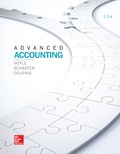
Concept explainers
a.
Identify the consolidation entry which would be required for these bonds on December 31, 2016.
a.
Explanation of Solution
The consolidation entry which would be required for these bonds on December 31, 2016:
| Entry B | ||||
| Date | Accounts Title and Explanation | Post Ref. | Debit ($) | Credit ($) |
| 12/31/2016 | Bond payable | 154,040 | ||
| Loss on retirement of Debt | 49,000 | |||
| Interest Income | 14,070 | |||
| Investment in Bonds | 198,870 | |||
| Interest expense | 18,240 | |||
| (being the intra-entity bonds and the loss on retirement recognized) | ||||
Table: (1)
Working note:
| Computation of Loss on Repurchase of Bonds | |
| Particulars | Amount |
| Cost of acquisition | $ 201,000 |
| Carrying amount of Bonds | $ 152,000 |
| Loss on repurchase | $ 49,000 |
| Computation of Investment in Bonds as on December 31, 2016 | |
| Particulars | Amount |
| Cost of acquisition | $ 201,000 |
| Amortization of premium: | |
| Cash interest | $ 16,200 |
| Interest income | $ 14,070 |
| Investment in Bonds as on December 31, 2016 | $ 198,870 |
| Computation of Bonds payable as on December 31, 2016 | |
| Carrying amount of Bonds | $ 152,000 |
| Amortization of discount: | |
| Cash interest | $ 16,200 |
| Interest expense | $ 18,240 |
| Bonds payable as on December 31, 2016 | $ 154,040 |
Table: (2)
Computation of interest expense:
Computation of interest income:
b.
Identify the consolidation entry which would be required for these bonds on December 31, 2018.
b.
Explanation of Solution
The consolidation entry which would be required for these bonds on December 31, 2018 is as follows:
| Entry *B | ||||
| Date | Accounts Title and Explanation | Post Ref. | Debit ($) | Credit ($) |
| 12/31/2018 | Bond payable | 158,884 | ||
| Investment in Company Z | 40,266 | |||
| Interest Income | 13,761 | |||
| Investment in Bonds | 194,152 | |||
| Interest expense | 18,759 | |||
| (being the intra-entity bonds and the loss on retirement recognized) | ||||
Table: (3)
Working note:
Computation of Interest Balances for 2017 followed by 2018:
| Interest Balances for 2017 followed by 2018 | |
| Interest income: $198,870 | $13,921 |
| Interest expense: $154,040 | $18,485 |
Table: (4)
Computation of Investment in Bonds Balance as on December 31, 2017:
| Investment in Bonds Balance, December 31, 2017 | |
| Carrying amount, January 1, 2017 | $ 198,870 |
| Amortization of premium: | |
| Cash interest | $ 16,200 |
| Effective interest income | $ 13,921 |
| Investment in Bonds balance as on December 31, 2017 | $ 196,591 |
Table: (5)
Computation of Bonds payable balance as on December 31, 2017:
| Bonds Payable Balance as on December 31, 2017 | |
| Carrying amount, January 1, 2017 | $ 154,040 |
| Amortization of discount: | |
| Cash interest | $ 16,200 |
| Effective interest expense | $ 18,485 |
| Bonds payable balance as on December 31, 2017 | $ 156,325 |
Table: (6)
Computation of Investment in Bonds balance as on December 31, 2018:
| Investment in Bonds Balance, December 31, 2018 | |
| Carrying amount, January 1, 2018 | $ 196,591 |
| Amortization of premium: | |
| Cash interest | $ 16,200 |
| Effective interest income | $ 13,761 |
| Investment in Bonds balance as on December 31, 2018 | $ 194,152 |
Table: (7)
Computation of Bonds payable balance as on December 31, 2018:
| Bonds Payable Balance, December 31, 2018 | |
| Carrying amount, January 1, 2018 | $ 156,325 |
| Amortization of discount: | |
| Cash interest | $ 16,200 |
| Effective interest expense | $ 18,759 |
| Bonds payable balance as on December 31, 2018 | $ 158,884 |
Table: (8)
Want to see more full solutions like this?
Chapter 6 Solutions
Soft Bound Version for Advanced Accounting 13th Edition
- Riverstone Publishers Inc. collects 80% of its sales on account in the month of the sale and 20% in the month following the sale. If sales on account are budgeted to be $450,000 for June and $380,000 for July, what are the budgeted cash receipts from sales on account for July?arrow_forwardNeed help this questionarrow_forwardSubject: financial accountingarrow_forward
- Hudson Textiles computes its predetermined overhead rate annually on the basis of direct labor hours. At the beginning of the year, it was estimated that 18,000 direct labor hours would be required for the period's estimated level of production. The company also estimated $88,000 of fixed manufacturing overhead expenses for the coming period and variable manufacturing overhead of $3 per direct labor hour. Hudson's actual manufacturing overhead for the year was $140,600 and its actual total direct labor was 19,000 hours. Compute the company's predetermined overhead rate for the year.arrow_forwardPlease help me solve this financial accounting problemarrow_forwardCan you help me solve this general accounting problem with the correct methodology?arrow_forward
- How much is Natasha's contribution margin ratio?arrow_forwardHello tutor please given General accounting question answer do fast and properly explain all answerarrow_forwardSuppose the required reserve ratio is 0.20 and individuals hold no cash. Total bank deposits are $150 million, and the banks hold $40 million in reserves. How much more money can the bank create if it does not hold excess reserves? Want Answerarrow_forward
 Financial AccountingAccountingISBN:9781305088436Author:Carl Warren, Jim Reeve, Jonathan DuchacPublisher:Cengage Learning
Financial AccountingAccountingISBN:9781305088436Author:Carl Warren, Jim Reeve, Jonathan DuchacPublisher:Cengage Learning Intermediate Accounting: Reporting And AnalysisAccountingISBN:9781337788281Author:James M. Wahlen, Jefferson P. Jones, Donald PagachPublisher:Cengage Learning
Intermediate Accounting: Reporting And AnalysisAccountingISBN:9781337788281Author:James M. Wahlen, Jefferson P. Jones, Donald PagachPublisher:Cengage Learning


